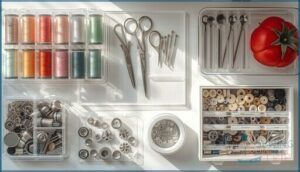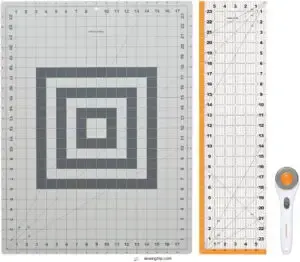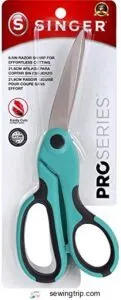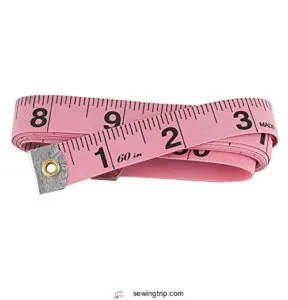This site is supported by our readers. We may earn a commission, at no cost to you, if you purchase through links.
Your grandmother made it look easy. She’d whip up curtains before lunch and hem a dress while dinner simmered. But somewhere between her generation and yours, sewing became this mysterious skill that seems impossibly complex.
Here’s what nobody tells you: learning how to teach yourself sewing doesn’t require fancy classes or years of practice. It needs the right tools, a few square feet of space, and the willingness to mess up a seam or two. Most people quit because they start with complicated projects or expect flawlessness from their first stitches.
The truth is, you can master basic techniques in a weekend and create your first wearable piece within a month. Your journey starts with understanding what actually matters and what’s just noise.
Table Of Contents
- Key Takeaways
- Getting Started With Self-Taught Sewing
- Essential Sewing Supplies for Beginners
- Choosing and Using a Sewing Machine
- Easy Sewing Projects and Practice Techniques
- Top 9 Sewing Products for Self-Taught Beginners
- 1. Brother CE4400 Electronic Sewing Machine
- 2. HAITRAL 24 Colors Sewing Thread Set
- 3. Fiskars Rotary Cutter Sewing Set
- 4. Singer ProSeries Heavy Duty Sewing Scissors
- 5. Saint Jane Large Floral Sewing Basket
- 6. Dritz Deluxe Blue Seam Ripper
- 7. Singer Pink Vinyl Tape Measure
- 8. Tomato Pin Cushion For Sewing
- 9. Dritz Tailors Chalk Pencil Multi Color
- Frequently Asked Questions (FAQs)
- Conclusion
Key Takeaways
- You can master basic sewing techniques in a weekend and create your first wearable piece within a month by starting with the right tools, realistic goals, and simple projects like pillow covers or drawstring pouches.
- Your beginner setup needs just four essentials—cutting tools (fabric scissors), measuring tools (tape measure and ruler), stitching supplies (8-12 needle sizes and all-purpose thread), and a basic sewing machine in the $120-$280 range.
- Practice on muslin fabric first because it costs 30-50% less than quilting cotton and shows mistakes clearly, helping you learn faster without wasting money on expensive materials.
- Most sewing problems stem from threading errors and tension issues, so always rethread your machine completely when you see thread bunching, and change your needle with each new project to prevent skipped stitches.
Getting Started With Self-Taught Sewing
Teaching yourself to sew is like learning any new craft—you’ll get there faster with the right foundation. You don’t need fancy equipment or years of experience to start creating things you’re proud of.
Here’s what you need to focus on first to build your skills with confidence.
Setting Realistic Goals and Expectations
Beginner sewing requires patience and realistic goal setting. Expect trial and error—your first projects won’t be perfect, and that’s okay. Set achievable goals like completing one beginner sewing project per month to avoid frustration.
Plan for a consistent time commitment, even 30 minutes weekly. Address challenges by embracing mistakes as learning opportunities. Consider using a notebook to track setting sewing goals effectively.
Understanding this motivation impact keeps you engaged while learning to sew at your own pace.
Understanding Basic Sewing Terms
As you set your goals, you’ll quickly discover that sewing for beginners hinges on understanding sewing terms. These words reveal patterns and tutorials. A sewing dictionary helps, but start with these essentials:
- Seam Allowances – the fabric space between your stitch line and edge
- Fabric Grain – how threads run through material
- Selvage Edge – the tightly woven border that won’t fray
Master backstitching to secure stitches. Understanding proper thread tension is also vital for quality stitches. Keep seam rippers handy for mistakes—you’ll use them often while learning.
Creating a Dedicated Sewing Space
Once you know the basics, you’ll need somewhere to work. Your sewing space doesn’t require a whole room—just 5 feet by 2 feet works. Think about space ergonomics: arrange your sewing tools, cutting table, and ironing board close together.
Good lighting setup matters. Natural light reduces eye strain by 45%. Organize your sewing box and fabric department nearby. Storage solutions keep everything within reach.
Building a Sewing Practice Routine
Now that your space is ready, daily practice makes all the difference. Ten minutes each day beats a weekly hour-long session for skill benefits. Short, focused bursts sharpen your hand-eye coordination and build muscle memory faster.
Structure each session around one task—straight seams today, buttonholes next time. This time management approach keeps practicing sewing techniques fun, not overwhelming, for beginners.
Essential Sewing Supplies for Beginners
You don’t need a huge collection of fancy supplies to start sewing. A few basic tools will get you through most beginner projects and help you build real skills.
Let’s walk through what belongs in your starter kit so you can begin creating without breaking the bank.
Must-Have Sewing Tools and Accessories
Your sewing kit needs four types of basic sewing tools to get started.
Cutting essentials like fabric scissors appear in 92% of beginner setups. For measuring accurately, you’ll want a flexible tape measure and clear ruler.
Stitching must-haves include 8 to 12 needle sizes and all-purpose thread.
Choosing The Right Fabric and Thread
For your first projects, cotton is your best friend—it behaves like a dream and doesn’t slip around. Linen also works beautifully and comes from sustainable fibres.
Always pre-wash fabrics to prevent shrinkage later. Match your thread to your fabric type, and you’ll cut visible seam errors by more than half. Thread count matters for strength too.
Understanding Different Types of Needles
Your needle choice shapes everything—from threading the needle to finished seam quality. Universal needles handle most woven fabrics, while ballpoint types protect knits. Match needle size to fabric weight: size 70/10 for silk, 100/16 for denim.
Industrial vs. domestic needles differ in durability, but home sewers rarely need heavy-duty options. Understanding needle point types makes projects smoother.
Organizing Your Sewing Kit
A tidy kit saves you time and frustration every session. Divide your supplies by function—threads, cutting tools, fasteners, needles—using transparent boxes or drawer organizers.
Storage solutions like bobbin cases and labeled compartments keep essentials visible and within reach. A pincushion near your machine and a sewing needle booklet protect sharp tools.
Market trends show sewists who embrace kit compartmentalization and supply categorization spend less time hunting for what they need.
Choosing and Using a Sewing Machine
Your sewing machine will become your most important tool, so it’s worth taking time to choose one that fits your needs and budget.
Once you have it, learning how to set it up and use its basic features is the real key to getting started. Here’s what you need to know about picking a machine and making it work for you.
Selecting The Best Sewing Machine for Beginners
Your first machine doesn’t have to break the bank or do everything under the sun. Most quality beginner sewing machines fall between $120 and $280, and brands like Brother, Singer, and Janome dominate the market for good reason. Here’s what separates the winners from the rest:
- Built-in stitches: Look for 14 to 70 options—enough variety without overwhelming you
- Drop-in bobbin with clear cover: Makes threading way less frustrating
- Automatic needle threader: Saves your eyes and patience
- Adjustable speed control: Lets you start slow and build confidence
- Free arm capability: Essential for hemming sleeves and pants
Models like the Brother CS7000X consistently top expert lists because they balance features with ease of use. The Singer Start 1304 won’t empty your wallet, while the Janome MOD-19 delivers excellent stitch quality. Don’t sleep on LCD screens for stitch selection—they increase satisfaction ratings quite a bit.
Budget considerations matter, but so does support. Machines with clear manuals see fewer returns, and all major brands now offer helplines and video libraries. About a third of beginners still prefer testing machines in-store before buying, which makes sense when you’re investing in your creative freedom.
Threading and Setting Up Your Machine
Threading your sewing machine feels like a puzzle at first, but it’s the foundation of every stitch you’ll make. Start with your bobbin threading—wind it through the tension disk until full, then insert it with the thread end forming a ‘P’ shape. Upper threading follows your machine’s numbered guides before passing through the needle eye front to back.
| Setup Step | Common Mistake | Quick Fix |
|---|---|---|
| Bobbin Threading | Overfilling bobbin case | Fill only to marked line |
| Upper Threading | Skipping tension discs | Follow each numbered guide |
| Thread Tension | Ignoring tension dial | Test on fabric scrap first |
| Machine Settings | Presser foot stays up | Always lower before sewing |
| Troubleshooting Issues | Bird nesting under fabric | Rethread upper path completely |
Your user’s manual shows the exact threading path for your model. Hold both thread ends, turn the handwheel once, and watch the bobbin thread pop up through the needle plate. That’s when you know you’ve nailed the sewing machine setup. Most thread breakage and bunching stems from rushing this step—take your time and you’ll avoid the frustration that trips up about 65% of beginners.
Key Features to Learn First
Once your machine is threaded, focus on four features that’ll carry you through most beginner sewing projects. Speed control lets you slow down on curves—about 67% of self-taught sewers say it’s a major advantage. The built-in needle threader saves you squinting sessions.
Master straight and zigzag stitches first; they’re your sewing basics workhorses.
Check your bobbin system window often—it prevents mid-seam surprises.
Maintenance and Troubleshooting Basics
Beyond machine setup, regular care keeps your sewing machine running smoothly. Clean lint from the bobbin area after every six bobbins. Change needles with each new project—it’s easier than fixing skipped stitches later. Oil your machine per the user’s manual, but don’t overdo it.
When thread bunches or tension feels off, try rethreading first. Trial and error teaches you common malfunctions fast.
Easy Sewing Projects and Practice Techniques
Building real skills means getting your hands on actual fabric and stitching real seams. You won’t learn by reading alone—you need to practice with projects that teach you fundamental techniques without overwhelming you.
Here’s how to start sewing in a way that builds confidence and gets you comfortable with your machine.
Starting With Straight Lines and Simple Seams
Mastering straight lines is your foundation for everything else in sewing. Start by watching the fabric edge—not the needle—to improve stitch accuracy by about 65%.
Use a seam guide or fabric chalk to mark a consistent allowance, usually 5/8 inch. Always backstitch at the start and end, preventing unraveling.
These basic sewing techniques transform wobbly beginners into confident sewers fast.
Practicing on Muslin Fabric
Once you’re comfortable with straight stitches, muslin becomes your best friend for beginner sewing. This affordable cotton fabric costs 30–50% less than quilting cotton, letting you practice freely without breaking the bank.
Muslin’s plain weave shows mistakes clearly, helping you learn faster.
- Test garment fit before cutting expensive fabric
- Try new construction techniques like darts and pleats safely
- Reuse scraps as cleaning cloths or compost them
Beginner-Friendly Patterns and Projects
Your first project shapes everything that comes after. Start with beginner-friendly patterns like pillow covers or drawstring pouches—over 70% of new sewists finish their first make within a week when they choose easy sewing patterns for beginners. Simple pattern selection matters: skip zippers and opt for straight seams.
Beginner projects with quick completion times see 65% higher project completion rates. Look for kit customization options and sustainable materials—30% of new launches now feature eco-friendly fabrics. These sewing projects for beginners build confidence fast, setting you up for skill expansion without frustration.
| Project Type | Time to Complete |
|---|---|
| Zipper pouch | 30 minutes |
| Tote bag | 45 minutes |
| Elastic-waist skirt | 1–2 hours |
| Table runner | 30 minutes |
| Pillow cover | 20 minutes |
Learning From Mistakes and Adjustments
Embracing trial and error in sewing accelerates your growth—70% of novice sewers credit mistakes for their biggest leaps forward. Iterative improvement through hands-on trial beats flawlessness every time.
Mistakes accelerate your sewing growth—70% of beginners credit trial and error for their biggest breakthroughs
Keep a seam ripper handy; you’ll use it on 85% of early projects. Track errors in a simple notebook to cut repeat mistakes by 40%.
Pattern alterations and tension adjustments get easier with each fix.
Top 9 Sewing Products for Self-Taught Beginners
The right tools make learning to sew much easier. You don’t need everything at once, but a few quality basics will set you up for success.
Here are nine products that’ll help you build your skills without breaking the bank.
1. Brother CE4400 Electronic Sewing Machine
The Brother International CE4400 gives you 40 built-in stitches and an automatic needle threader—perfect when you’re learning to use a sewing machine. This sewing machine for beginners delivers solid user ratings at 4.5 out of 5, with consistent performance and quiet operation.
You’ll get a 25-year limited warranty support, plus lifetime troubleshooting help. Machine features include an LCD screen and adjustable speed control for sewing machine basics.
The price range sits between $130 and $200, making it accessible for self-taught sewers starting their journey.
2. HAITRAL 24 Colors Sewing Thread Set
You’ll find 24 distinct colors waiting in the HAITRAL thread set—each spool holds 1,000 yards of durable polyester. Thread quality holds up well for basic sewing and repair projects, and the color variety accommodates everything from embroidery details to garment construction.
Set affordability stands out at roughly $22, making it budget-friendly for beginners building their sewing supplies. Project compatibility spans most household machines, so you won’t face tension issues as you practice. This entry-level option fits perfectly on any beginner sewing supply list.
3. Fiskars Rotary Cutter Sewing Set
Precision cutting transforms fabric work from frustrating to fluid. The Fiskars Rotary Cutter Sewing Set bundles a 45mm blade, 18×24-inch cutting mat, and 6.5×24-inch ruler—three essential sewing supplies in one package.
Ruler accuracy keeps your seams straight, while the ergonomic design reduces hand fatigue during long cutting sessions. Safety features include magnetic blade replacement that protects your fingers.
This complete kit gives beginners proper sewing tips for clean cuts through multiple fabric layers—a skill that makes every project look more professional.
4. Singer ProSeries Heavy Duty Sewing Scissors
Sharp fabric scissors make the difference between clean edges and frayed messes. The Singer ProSeries Heavy Duty Sewing Scissors feature tempered stainless steel blade material that cuts through multiple fabric layers without snagging—essential for beginner sewing tips that actually work.
The ergonomic design with rubberized handles reduces hand fatigue during long projects. Strong cutting performance works with everything from silk to denim, while durability ensures years of reliable use.
At their market position, these scissors deliver professional results without the premium price tag—smart sewing supplies needed for self-taught success.
5. Saint Jane Large Floral Sewing Basket
Good scissors need a home. The Saint Jane Large Floral Sewing Basket gives you dedicated storage capacity with a lift-out tray and built-in pockets for organizing everything you’re learning to sew with.
At 10.5 x 10.5 x 7.75 inches, you’ll fit all your sewing supplies needed without hunting through drawers. User ratings consistently hit 4.8 out of 5 stars for basket organization that actually works.
Price trends show it retailing between $29.99 and $49.99—smart floral durability for beginners mastering sewing for beginners basics.
6. Dritz Deluxe Blue Seam Ripper
You’ll make mistakes—that’s where the Dritz Deluxe Blue Seam Ripper earns its place in your sewing supplies.
This 5¼-inch tool features blade sharpness that cuts through unwanted stitches cleanly, while its ergonomic handle prevents hand fatigue during longer corrections. The safety features include a protective ball that won’t snag delicate fabric and a clear cap for storage.
Priced between $4.19 and $5.99, it delivers serious value for any beginner learning sewing basics. Some users even find alternative uses like pet grooming—proof of its precision design.
7. Singer Pink Vinyl Tape Measure
Accurate measurements separate a well-fitted garment from a frustrating project, which is why a reliable measuring tape belongs in your beginner sewing supplies. The Singer Pink Vinyl Tape Measure stretches 60 inches and shows both inches and centimeters—handy when you’re learning to sew with international patterns.
Its pink color benefits include high contrast against most fabrics, and the measurement scale accuracy stays consistent even after repeated use. Metal tabbed edges guarantee vinyl tape durability, preventing fraying at the ends.
At around $4.99, it outperforms market competition analysis in both user accessibility features and price point.
8. Tomato Pin Cushion For Sewing
You’ll need somewhere safe to park your pins while you work, and the classic Tomato Pin Cushion brings both function and a bit of historical symbolism to your sewing supplies. That bright red tomato shape—measuring 2.5 inches—started in 15th-century Europe as a good luck charm.
The attached emery strawberry sharpens pins as you use them, extending their life by up to 40%. Design materials include foam filling and knitted fabric that holds 80–100 pins securely. It’s a beginner-friendly essential that keeps your pins organized and within reach.
9. Dritz Tailors Chalk Pencil Multi Color
Precision matters when you’re transferring pattern markings to fabric, and the Dritz Tailors Chalk Pencil gives you three fabric chalk colors—white, yellow, and blue—for clear visibility on different materials. This compact tool draws finer lines than traditional chalk, perfect for marking hems and darts as you’re sewing for beginners.
The chalk refills cost around $4.49 and brush away easily after use. Some users report pencil durability issues with frequent breaking, so keep extra refills in your sewing supplies for uninterrupted marking precision levels.
Frequently Asked Questions (FAQs)
What are some good online communities for connecting with other beginner sewers?
Before the internet, you’d hunt down a local quilting bee. Now you can join Reddit r/sewing with 561,000 members, SewForum, MySewingCircle groups, or Facebook sewing communities for instant support and step-by-step sewing tutorials.
My machine is skipping stitches – what should I check first to troubleshoot this?
Check your needle condition first—a dull or bent needle causes most skipped stitches.
Then verify thread compatibility, clean your machine’s bobbin area, adjust tension settings, and examine your fabric handling technique.
How do I know what size needle to use for different fabrics?
Fine fabrics favor finer needles—size 60 to 70—while heavyweight materials like denim demand thicker needles around 90 to Match your needle to fabric weight and thread thickness for better stitch quality.
How do I fix common sewing machine problems?
Most domestic sewing machine problems stem from thread tension, needle breakage, bobbin jams, or fabric feeding issues.
Your user’s manual guides you through stitch regulation adjustments and cleaning to keep everything running smoothly.
Whats the difference between woven and knit fabrics?
Woven fabrics use interlaced threads at right angles, creating stable textiles with minimal stretch. Knit fabrics loop yarns together, giving them natural elasticity and flexibility.
Understanding these fabric construction differences helps you choose the right material for each project.
How do I read and follow sewing patterns?
Understanding sewing patterns starts with size selection using body measurements, then learning pattern symbols like grainlines and notches.
Follow lay plans carefully, read instructions thoroughly, and mark fit adjustments on beginner-friendly patterns before cutting.
Can I sew without owning a machine?
The best things in life don’t need a plug—and that includes sewing. Hand stitching with a needle and thread works beautifully for repairs, embroidery, and small projects, costing under $10 to start.
How do I hem pants or skirts properly?
Hemming techniques start with accurate measuring and marking. Press your fold twice with a hot iron, pin carefully, then sew with a straight stitch.
This professional finish prevents fraying and creates lasting adjustments to garments.
Conclusion
Rome wasn’t built in a day, and neither is sewing mastery. You’ve got the roadmap now—the tools, techniques, and beginner projects that’ll transform fabric into something you actually made.
How to teach yourself sewing boils down to consistent practice and forgiving yourself for crooked seams. Start with that first straight stitch today. Your grandmother didn’t wait for perfect conditions, and neither should you.
The needle’s threaded. What’s stopping you?
- https://www.threadsmagazine.com/forum/what-not-many-sewers
- https://www.reddit.com/r/sewing/comments/ds78j1/so_how_many_of_you_are_selftaught/
- https://www.globusedujournal.in/wp-content/uploads/2020/05/Raynor-Ereje-GJEJJ20-PP-49-58.pdf
- https://preply.com/en/blog/online-learning-statistics/
- https://www.publishersweekly.com/pw/by-topic/industry-news/financial-reporting/article/98811-print-book-sales-dip-0-9-in-first-nine-months-of-2025.html


















